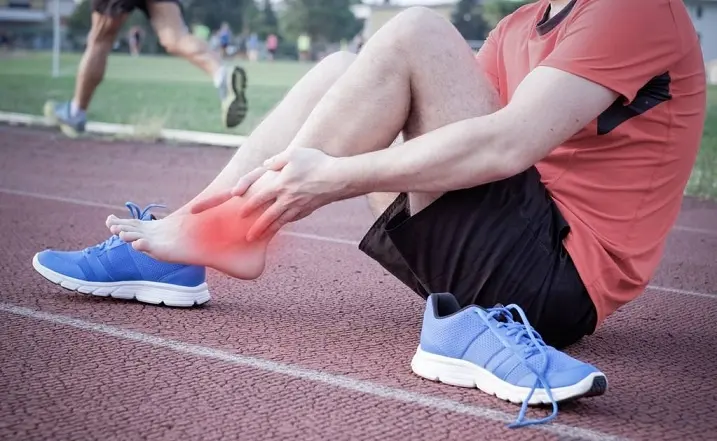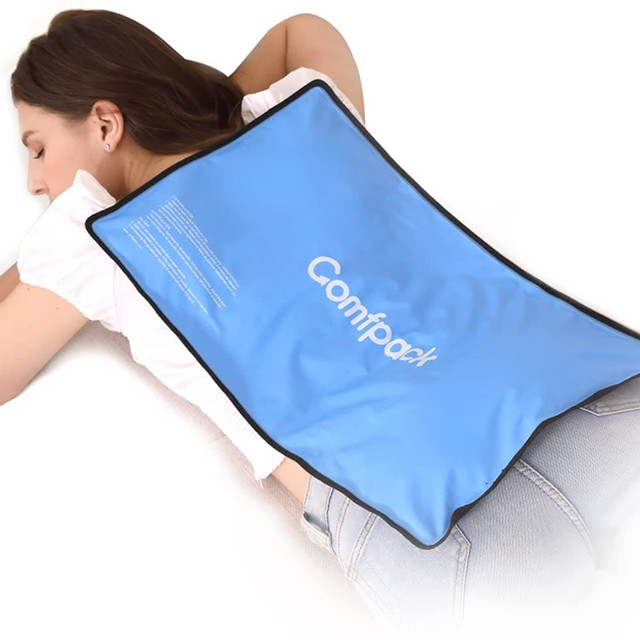By Comfpack | 15 April 2022 | 0 Comments
Do you know how to properly use ice packs to relief muscle damage?
Many people should know that cold therapy need to be applied in time after an injury, but do you know why cold therapy are needed?
Correct application of cold therapy can effectively relieve joint swelling and pain. Because cold compresses can effectively reduce local blood flow, thereby reducing pain, and can also speed up wound healing. Cold compresses can be very effective in the acute phase after injury and in the swelling phase after surgery.
Next, we will explain in detail how cold packs work and how to use cold packs safely and effectively.

1. What problems will occur if the injury is not iced?
When an injury occurs, ignoring the location of the swelling can cause two major problems.
First, some of the chemicals present in the fluid that causes swelling can continuously stimulate nerve fibers, producing pain.
Second, joint space is limited, and pressure from swelling creates pain and limits joint mobility. For example, if the knee is swollen, the bending and straightening of the joint will be greatly affected.
2. Remember these numbers for cold therapy application
Cold packs are most effective when applied immediately after injury and surgery, especially within the first 2-3 days.
Never exceed 15 minutes to avoid frostbite. While the freezing effect of ice blocks slows blood flow, it also prevents the efficient delivery of beneficial nutrients to the site of injury, which can effectively promote healing. At the same time, the chemicals that cause swelling are difficult to carry quickly away from the damaged tissue. On the other hand, if the skin freezing practice is too long, the Hunting Effect of human blood vessels will dilate the local microvessels, allowing more blood to flow into the swollen area.
Remove the cold packs after 15 minutes and allow the swollen area to return to normal body temperature for at least 2 hours. Maintain a certain frequency of ice compresses as much as possible, such as 4-5 times a day, to maximize the effect of reducing swelling and pain.
3. Different methods to achieve Cold Therapy
1) Cold packs: Dedicated Cold packs can be purchased. It can ensure a longer freezing effect and can better stick to the affected area. Usually designed in different sizes.
2) Frozen peas: Put the peas in the refrigerator for a period of time and take them out, wrap them in plastic bags or cloths, usually to achieve the effect.
3) Homemade ice cubes: freeze ice cubes in the refrigerator, mash them into small pieces, put them in a plastic bag, and add a little water to better adhere to the affected area. But remember to wrap it with cloth to avoid sticking it directly to the damaged area.
4) Professional cold packs: such as knee cold pads, ankle ice packs, They are different from ordinary ice packs in that the cold is more uniform and lasts longer, more convenient to use, not in direct contact with the skin.

4. Safety Instructions
1) Do not apply cold packs when there is no feeling in the swollen part of your injury, such as joints that cannot feel touch. Before applying cold packs, you need to check for nerve damage.
2) If you have high blood pressure, use cold packs packs with caution. Cold therapy can narrow your blood vessels, which can continue to increase blood pressure.
3) Do not apply ice directly to the skin. Place a thin cloth over the affected area to avoid frostbite. In this case, it is recommended to choose a Professional cold packs.
Correct application of cold therapy can effectively relieve joint swelling and pain. Because cold compresses can effectively reduce local blood flow, thereby reducing pain, and can also speed up wound healing. Cold compresses can be very effective in the acute phase after injury and in the swelling phase after surgery.
Next, we will explain in detail how cold packs work and how to use cold packs safely and effectively.

1. What problems will occur if the injury is not iced?
When an injury occurs, ignoring the location of the swelling can cause two major problems.
First, some of the chemicals present in the fluid that causes swelling can continuously stimulate nerve fibers, producing pain.
Second, joint space is limited, and pressure from swelling creates pain and limits joint mobility. For example, if the knee is swollen, the bending and straightening of the joint will be greatly affected.
2. Remember these numbers for cold therapy application
Cold packs are most effective when applied immediately after injury and surgery, especially within the first 2-3 days.
Never exceed 15 minutes to avoid frostbite. While the freezing effect of ice blocks slows blood flow, it also prevents the efficient delivery of beneficial nutrients to the site of injury, which can effectively promote healing. At the same time, the chemicals that cause swelling are difficult to carry quickly away from the damaged tissue. On the other hand, if the skin freezing practice is too long, the Hunting Effect of human blood vessels will dilate the local microvessels, allowing more blood to flow into the swollen area.
Remove the cold packs after 15 minutes and allow the swollen area to return to normal body temperature for at least 2 hours. Maintain a certain frequency of ice compresses as much as possible, such as 4-5 times a day, to maximize the effect of reducing swelling and pain.
3. Different methods to achieve Cold Therapy
1) Cold packs: Dedicated Cold packs can be purchased. It can ensure a longer freezing effect and can better stick to the affected area. Usually designed in different sizes.
2) Frozen peas: Put the peas in the refrigerator for a period of time and take them out, wrap them in plastic bags or cloths, usually to achieve the effect.
3) Homemade ice cubes: freeze ice cubes in the refrigerator, mash them into small pieces, put them in a plastic bag, and add a little water to better adhere to the affected area. But remember to wrap it with cloth to avoid sticking it directly to the damaged area.
4) Professional cold packs: such as knee cold pads, ankle ice packs, They are different from ordinary ice packs in that the cold is more uniform and lasts longer, more convenient to use, not in direct contact with the skin.

4. Safety Instructions
1) Do not apply cold packs when there is no feeling in the swollen part of your injury, such as joints that cannot feel touch. Before applying cold packs, you need to check for nerve damage.
2) If you have high blood pressure, use cold packs packs with caution. Cold therapy can narrow your blood vessels, which can continue to increase blood pressure.
3) Do not apply ice directly to the skin. Place a thin cloth over the affected area to avoid frostbite. In this case, it is recommended to choose a Professional cold packs.
Leave a Reply
Your email address will not be published.Required fields are marked. *
POPULAR BLOG
CATEGORIES